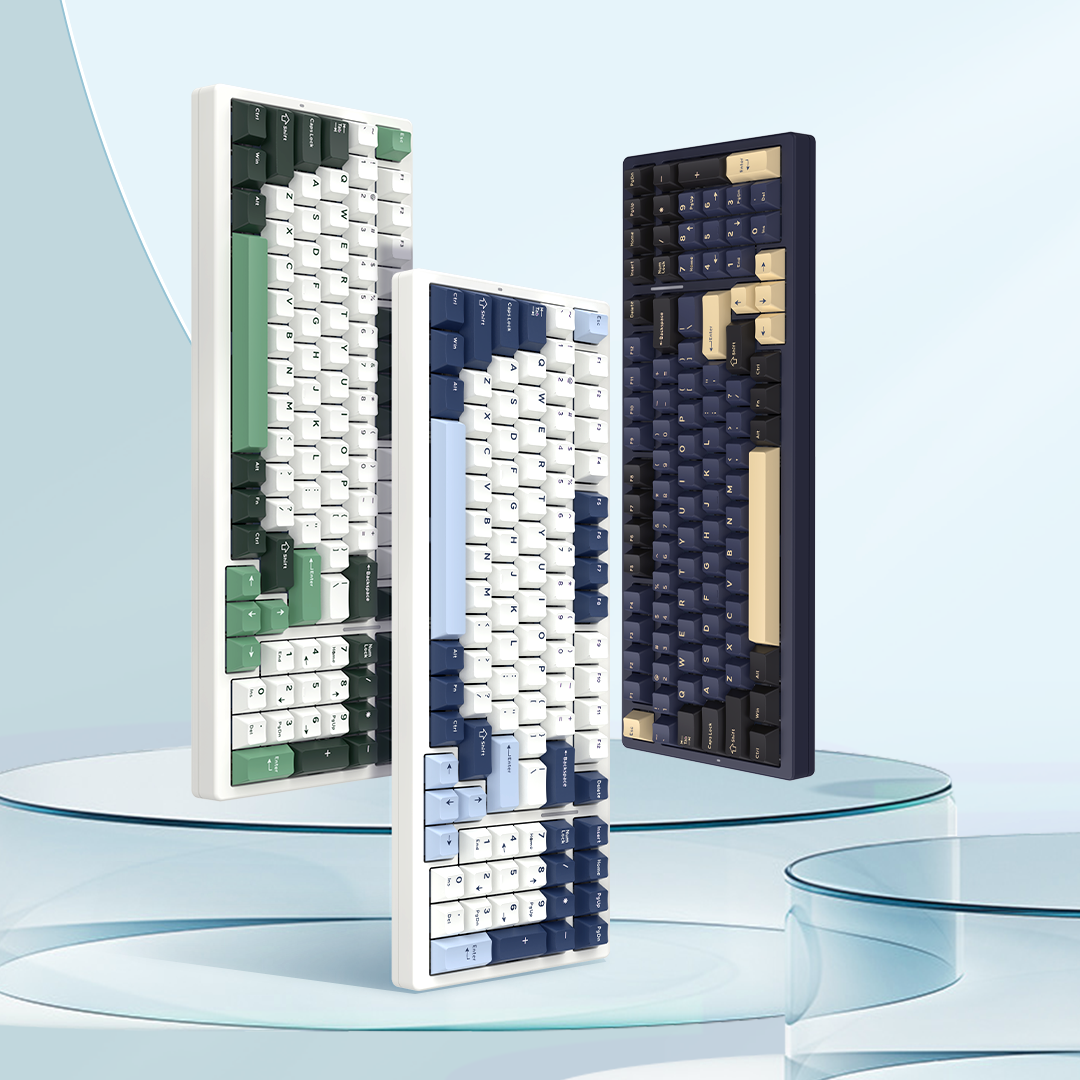Beste kabellose cremige Tastaturen – Top glatte Auswahl 2025
Haben Sie jemals erlebt, dass Ihre kabellose Tastatur beim Drücken hängen bleibt oder sich kratzig statt geschmeidig anfühlt? Steife, unbeholfene Tastendrücke sind ein häufiges Ärgernis – und selten zufällig.
Drei Hauptverursacher sind für die Frustration verantwortlich: billige, nicht geschmierte Schalter, die rauh reiben statt zu gleiten; enge kabellose Designs, die die Ausrichtung der Schalter zugunsten der Portabilität opfern, was zu ungleichmäßigen Gefühlen führt; und Verzögerungen oder Konnektivitätsprobleme, die Tastenanschläge steifer erscheinen lassen, als sie tatsächlich sind.
Diese Probleme verlangsamen Gamer, belasten Schreiber und zerstören die Produktivität. Aber 2025 ändert das. Die Einführung von kabellosen „cremigen“ Tastaturen – unter den Highlights dieses Jahres.beste Gaming-Tastaturen: entwickelt, um Steifheit an der Quelle zu beheben, mit ultra-glattem Schaltern und intelligenter Technik. Lassen Sie uns untersuchen, warum sie die Nutzer überzeugen.
Warum drahtlose cremefarbene Tastaturen 2025 dominieren
2025 ist das Jahr, in dem kabellose „creamy“ Tastaturen übernommen haben – und das aus gutem Grund. Hier ist, warum sie dominieren:
Zuerst beendete die drahtlose Technologie endlich das „Kompromiss“-Zeitalter. Marken wie Razer und VGN verfeinerten Protokolle, um Latenzzeiten von unter 1 ms zu erreichen, was der Präzision kabelgebundener Geräte für Gamer entspricht. Bluetooth 5.3-Upgrades ermöglichen nahtloses Wechseln zwischen 3+ Geräten, was sie für Multitasker unverzichtbar macht. Kein Verzicht mehr auf Reaktionsfähigkeit für drahtlose Freiheit.
Zweitens wurde das „cremige“ Gefühl zum Mainstream. Die Nutzer verlangten nach mehr Geschmeidigkeit, also setzten die Marken auf werksseitig geschmierte Schalter, Gasket-Mounts und POM-Stifte mit geringem Reibungswiderstand. Modelle wie die Q-Serie von Keychron und das VGN V98PRO V3 von VGN erhielten Lob für ihre „seidenweichen Tastenanschläge“ – wodurch sich „cremig“ von einem Nischenterm zu einer der wichtigsten Kaufkriterien entwickelte.
Drittens haben sich Akkulaufzeit und Design verbessert. Die Top-Modelle von 2025 bieten über 1.000 Stunden Laufzeit (Cherry MX 8.2 erreicht über 2.000), sowie Schnellladefunktion (10 Minuten = 24 Stunden). Kompakte Layouts sparten Platz, während hochwertige Materialien die Haltbarkeit erhöhten.
Zuletzt arbeiten sie für alle: Unter 2025’sbeste Gaming-Tastaturen, Gamer lieben ihre schnellen Klicks; Remote-Arbeiter loben den ganztägigen Komfort, und Kreative genießen die leise Tastenaktion. Im Jahr 2025 sind kabellose cremige Tastaturen kein Trend – sie sind der neue Standard.

Was definiert eine "cremige" Tastatur?
Eine „cremige“ Tastatur ist nicht nur ein Schlagwort – es ist eine sorgfältig entwickelte Tipp-Erfahrung, die sich mühelos, geschmeidig und fast luxuriös anfühlt, egal ob du stundenlang spielst oder E-Mails schreibst. Um sie zu definieren, müssen wir die wesentlichen Elemente zerlegen, die zusammen dieses charakteristische „buttrige“ Gefühl erzeugen, von den Schaltern unter den Tasten bis hin zur Art und Weise, wie die gesamte Tastatur mit deinen Fingern interagiert.
Zunächst und vor allem: lineare Schalter – das Rückgrat vieler...beste mechanische Tastatur. . Im Gegensatz zu „taktilen“ Schaltern (die eine spürbare Erhöhung bei der Betätigung aufweisen) oder „klickenden“ Schaltern (die ein hörbares Klicken erzeugen), bieten lineare Schalter einen geraden, ungehinderten Weg von oben nach unten. Das bedeutet keine abrupten Unterbrechungen – nur ein sauberes, gleichmäßiges Gleiten vom Moment des Tastendrucks bis zum Anschlag. Aber nicht alle linearen Schalter sind gleichwertig. Was sie „cremig“ macht, ist die Zugabe einer werkseitigen Schmierung. Diese Schmierung beseitigt das kratzige Metall-auf-Plastik-Reiben, das billigere Schalter plagt, und verwandelt einen steifen Druck in eine seidig weiche Bewegung.

Als Nächstes: Gehäuse mit Dichtungsring-Konstruktion. Herkömmliche Tastaturen verwenden oft „Top-Mount“- oder „Plate-Mount“-Designs, bei denen die Schalter fest an einer starren Metallplatte befestigt sind, was ein steifes, hartes Gefühl erzeugt, wenn die Tasten vollständig heruntergedrückt werden. Cremige Tastaturen hingegen verwenden einen flexiblen Dichtungsring – eine dünne Schicht aus Gummi oder Silikon – zwischen der Schalterplatte und dem Tastaturgehäuse. Dieser Dichtungsring wirkt wie ein Stoßdämpfer und mildert den Aufprall, wenn die Tasten ihren tiefsten Punkt erreichen. Anstatt eines scharfen „Klacks“ oder eines starren Stoppes erhalten Sie ein sanftes, gepolstertes Auslösen, das bei langen Sitzungen weniger ermüdend ist. Deshalb beschreiben Tester gasket-mounted Tastaturen oft als „gedämpft“ oder „kissenartig“ im Vergleich zu ihren steiferen Gegenstücken.

Die Keycaps: dicke, hochwertige PBT (Polybutylenterephthalat)-Keycaps neigen weniger dazu, sich zu verformen oder im Laufe der Zeit einen „Glanz“ zu entwickeln, wodurch das glatte Gefühl erhalten bleibt. Selbst die Schaltergehäuse spielen eine Rolle – poliertes, präzisionsgefertigtes Kunststoff sorgt dafür, dass der Stift ohne Wackeln oder Reibung bewegt wird.

Schließlich geht es um Konsistenz. Ein wirklich cremiges Keyboard hat keine „guten“ oder „schlechten“ Tasten – jeder Schalter fühlt sich identisch an, von der Leertaste bis zur kleinsten Funktionstaste. Diese Uniformität resultiert aus engen Fertigungstoleranzen: keine verkippten Stämme, keine ungleichmäßige Schmierung, nur ein nahtloses Tipp-Erlebnis, das es Ihnen ermöglicht, sich auf die Aufgabe zu konzentrieren, egal ob Sie eine Kombination in einem Spiel meistern oder einen Roman schreiben.
Kurz gesagt, zusammen schaffen diese Elemente das Gefühl des „mühelosen Gleitens“, das das Tippen oder Spielen von einer lästigen Aufgabe in ein Vergnügen verwandelt.
Die richtige cremige Tastatur für Sie auswählen
Die VGN V98Pro V3 glänzt als Top-Auswahl im Bereich der cremigen Tastaturen, indem sie hochwertige Funktionen mit einem erschwinglichen Preis kombiniert. Im Kern verfügt sie über ein gasket-mounted Design, gepaart mit fünf Schichten schalldämmenden Schaums (einschließlich Poron und IXPE), um die Tastenanschläge zu mildern und Vibrationen zu absorbieren, was ein weiches, gepolstertes Gefühl erzeugt, das den Begriff „cremiges“ Tippen definiert.
Es bietet drei Schalteroptionen, um Präferenzen gerecht zu werden:
Viele der beste mechanische TastaturOptionen: Cow Switch, ein 37g linearer Schalter mit einem Aktuationspunkt von 1,9mm für sanfte, federleichte Tastendrücke und einen „HiFi“-Klang; Daiyu Switch, eine lautlose lineare Wahl, ideal für geräuschempfindliche Umgebungen; und Arctic Fox Switch, übernommen von der V2, die einen subtilen taktilen Widerstand hinzufügen.

Mit einer Akkulaufzeit von bis zu 50 Tagen im Energiesparmodus dank seines 10.000mAh-Akkus und Schnellladefunktion für zusätzlichen Komfort meistert es lange Sitzungen mühelos. Die Tri-Modus-Konnektivität – Bluetooth 5.0, 2,4GHz Wireless (mit 1ms Latenz) und USB-C Kabelverbindung – ermöglicht nahtloses Wechseln zwischen Geräten, während robuste PBT Doppelschuss-Tastenkappen Glanz und Abnutzung widerstehen. Das kompakte 98-Tasten-Layout (mit dediziertem Ziffernblock) spart Schreibtischplatz. Es ist ideal für Gamer (dank niedriger Latenz), Remote-Arbeiter (leise Modi und lange Akkulaufzeit) sowie Anpassungsenthusiasten (hot-swap Sockel und webbasierte Treiber für Tastenbelegung und RGB-Anpassungen) – was es zu einem preiswerten Juwel macht.










